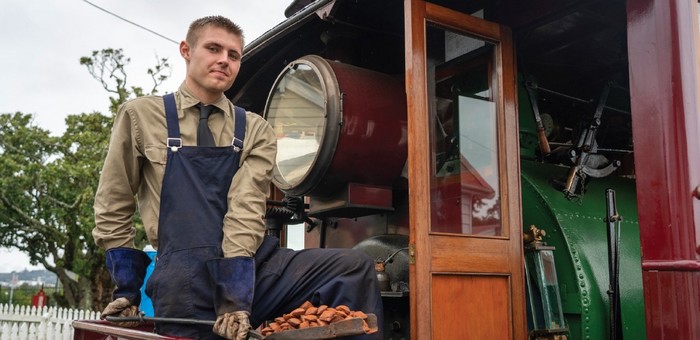Steam tram powered by trees
Forest residues have successfully replaced coal as a low carbon fuel source in a large-scale, partnership trial with the Museum of Transport and Technology (MOTAT).
It was out with the coal and in with the biofuel for steam tram no. 100, which operated on a renewable energy source made from trees at MOTAT Live Day on August 20.
The biofuel was developed by Scion under its Integrated Bioenergy portfolio. Live Tram Day was the project’s largest trial to date, with 250 kilograms of biofuel briquettes supplied to MOTAT to keep the little tram that could, running all day.

It was also a chance to highlight the opportunities available as New Zealand transitions from fossil fuels to renewable energy sources, to reduce our greenhouse gas emissions.
More than 1100 visitors attended the museum’s annual tram celebration with tram no. 100 the most popular of the day.
Scion’s biofuel performed well, with valuable feedback provided by MOTAT tramway volunteer, Tony Messenger, who has worked with tram no. 100 for more than 50 years.
“The fuel burned cleanly with minimal smoke and noticeably less fumes. You certainly did not get that taste in your throat or smell in your clothes that you get when burning coal,” he says.
“The briquettes allowed a better fire grate covering than coal and as a result, the boiler steamed well and easily maintained pressure. We were able to maintain a more constant, steady fire and that is a plus.
“We would be very happy to switch to this fuel in place of coal.”
Scion scientist Karl Molving noted further work is required to reduce the volume of briquette dust and further improve combustion performance. Both coal and briquette ash samples were collected for testing.
Scion anticipates its briquette ash will be cleaner and less corrosive, which should improve boiler lifespans.
From forest to fuel
The briquettes are made using forest residues such as bark, branches, and low-quality stem wood – all woody biomass that is currently seen as a waste product in the industry. Scion is on a mission to unlock the potential of this ‘waste’, seeing opportunity in the estimated 4 million tonnes of harvest and thinning residues that currently remain in production forests.
While more than 2 million tonnes of coal were burned in New Zealand in 2022, there has never been a more critical time to find an alternative to fossil fuels.
Scion Integrated Bioenergy portfolio lead Paul Bennett believes forestry may hold the solution for providing coal burners with a clean and renewable energy source.
“Energy use contributes to around 90% of New Zealand’s carbon dioxide emissions. If Aotearoa is going to achieve its net zero target, it needs to address emissions from energy use.
“This is currently the most achievable target for New Zealand to reduce carbon emissions. However, it’s not a target that can be achieved only by Scion. It requires connections with the industry and the public.
“To bring biofuel to the market and successfully replace coal, the technology needs to be tested at a range of scales. This partnership with MOTAT was the ideal first step to demonstrate the effectiveness of biomass briquettes at a larger scale, with a like-minded company that wants to reduce its environmental impact,” Bennett says.![]()
